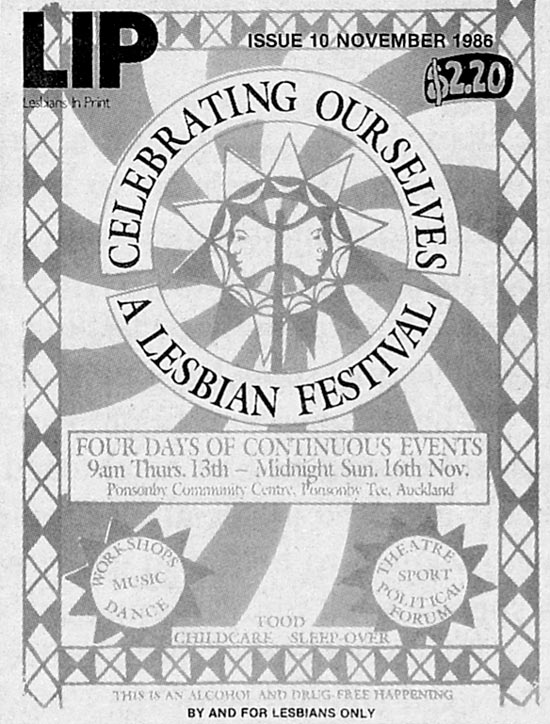This essay written by Romi Curl was first published in Women together: a history of women's organisations in New Zealand in 1993. It was amended with a postscript by Alison Laurie in 2019.
The first issue of the magazine Lesbians In Print (LIP) was launched in Auckland in May 1985, in a climate of political activity focused on the Homosexual Law Reform Bill. LIP grew out of the need for a voice for the lesbian community, which had by then become active and cohesive. The early issues dealt with the struggle lesbians were having to be recognised by the Gay Task Force (a group of gay men and lesbians working with Fran Wilde MP for the bill) in Auckland. As a result the Lesbian Coalition (Auckland) was formed. That same year, Snapdragon, the women's bookshop in Herne Bay, was started and run by lesbians. It was a meeting place, a centre of ideas and activity, and the perfect outlet for LIP.
The initial collective consisted of nine women who at first put out the magazine every two months, but later less regularly. The first seven issues of LIP dealt with the bill, until it was finally passed in 1986. Other frequent themes were lesbians and alcohol, lesbian motherhood, spirituality, art, peace, the environment, health, visibility, the Treaty of Waitangi, and the Australian Bicentenary – issues which touched lesbians' lives directly, but also broader concerns for the community and the planet.
LIP published many personal stories about the pain and joys of discovering lesbianism and 'coming out'. Issue 7 (1986) carried Rose Ruston's article 'Lesbian Separatism', which drew a long, complex series of responses, for and against.

Romi Crul.
Cover of Lesbians in Print, Issue 10, November 1986.
The photos and articles covering the lesbian festival 'Celebrating Ourselves', held in Ponsonby in November 1986, showed the elation of being together and having resolved many conflicts. Lesbian musicians, their stories and their gigs received plenty of coverage, as did the Women's Music Festivals of 1987 and 1988, along with lesbian paintings, poems, stories and cartoons. Circe, the Auckland lesbian soccer and softball team, also featured often.
Issue 18 (1988), 'Wāhine Māori', published work put together by a group of Māori lesbians, covering Waitangi Day, support for Koori women, racism at an Auckland gay club, and women working with sexual abuse. But by 1988, energy had begun to wane. There were no major events or issues to focus on, and material became more difficult to elicit. Instead of an editorial collective, there was only a paste-up team of two women (both of whom had been involved since Issue 2). In 1989, Issue 21 – LIP's coming of age – was also the last by this collective.
A new collective took over from 1989; however, the last issue of Lesbians in Print was No. 26 in 1992. After that, the lesbians working on it began to leave, including Romi Curl and the late Kerryn Perkins. The format used was costly, making the publication expensive, and many lesbian friendship groups bought just one copy for everyone to borrow and read. LIP had therefore become uneconomic to produce, as sales could not cover costs, and it ceased production.
Postscript
Tāmaki Makaurau Lesbian News replaced LIP, and was successful until its format changed to colour printing, which also made it too costly to produce. In 2015 it became a website, Lesbian News Aotearoa [1]. However, this ceased to operate in April 2019. The final statement explained that the group had become too small, and did not have enough time or energy to continue. It went on:
A lot of lesbians have contributed over these 28 years: developing and sourcing ideas, writing stories, taking photographs, creating the monthly layout, proof reading, enveloping the print newsletter, processing subscriptions, updating group listings. A lot of cake has been eaten and coffee drunk each month. Readers have been very important – our reason for establishing and continuing publication – and have also directly contributed stories and ideas.
We are not disappearing. All the existing monthly updates remain accessible and searchable on the website. We will continue to maintain the Facebook page (facebook.com/tmlnnewzealand), and will check the email address every so often ([email protected]). [1]
Romi Curl and Alison Laurie
Notes
[1] https://lesbianaotearoa.wordpress.com
Published sources
LIP, 1985–1989, 1989–1992

Community contributions